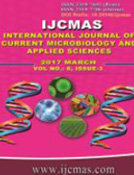


 National Academy of Agricultural Sciences (NAAS)
National Academy of Agricultural Sciences (NAAS)

|
PRINT ISSN : 2319-7692
Online ISSN : 2319-7706 Issues : 12 per year Publisher : Excellent Publishers Email : editorijcmas@gmail.com / submit@ijcmas.com Editor-in-chief: Dr.M.Prakash Index Copernicus ICV 2018: 95.39 NAAS RATING 2020: 5.38 |
In the present study, all the three selected varieties of chilli viz. G-4, NP-46 and Faridabad were susceptible to dry root-rot caused by Rhizoctonia solani. The different modes of application of Trichoderma harzianum were found effective to manage the dry root rot but most effective was found with dry seed treatment. The population density (cfu) of Rhizoctonia solani increased till 30 days after sowing (DAS) then it was stagnant and decreased up to 60 DAS while in case of Trichoderma harzianum the cfu increased up to 30 DAS and then gradually decreased up to 45 DAS and remained stagnant up to 60 DAS. The dry root rot was managed by Trichoderma harzianum to maximum extent up to 30 DAS after which the disease incidence increased, which may be ascribed to variations in the rhizosphere which may had adverse impact on further colonization by Trichoderma harzianum but however, it showed effectiveness up to 30 DAS.
 |
 |
 |
 |
 |